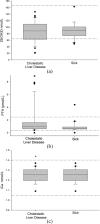Serum vitamin D status in sick cats with and without cholestatic liver disease
- PMID: 31916866
- PMCID: PMC10814402
- DOI: 10.1177/1098612X19895081
Serum vitamin D status in sick cats with and without cholestatic liver disease
Abstract
Objectives: Vitamin D deficiency accompanies chronic cholestatic liver disease (CLD) in humans. The vitamin D status of cats with CLD is unknown. The objectives of this study were to describe serum vitamin D concentrations in cats with CLD and to determine if they correlated with indices of liver disease severity.
Methods: Thirty-six cats with CLD, defined by increases in serum bilirubin and serum alanine aminotransferase, and 23 sick cats with non-hepatobiliary diseases were prospectively enrolled. Serum 25-hydroxyvitamin D (25[OH]D), parathyroid hormone (PTH) and ionized calcium were measured. Signalment, clinical signs, comorbidities, diet history, serum bilirubin, liver enzyme activity, albumin, phosphorus, white blood cell count, prothrombin time and final hepatic cytologic/histopathologic diagnosis, when available, were recorded.
Results: Median serum 25(OH)D levels were similar in cats with CLD (89.5 nmol/l; range 21-112 nmol/l) and sick cats (89.0 nmol/l; range 49-115 nmol/l). Overall 12/36 (33%) cats with CLD and 4/23 (17%) sick cats had 25(OH)D levels below the lower limit of the reference interval (<65 nmol/l). Median PTH concentrations in cats with CLD were significantly higher (0.95 pmol/l; range 0-11.3 pmol/l) than in sick cats (0.70 pmol/l; range 0.5-6 pmol/l). In cats with CLD, 6/36 (17%) had high PTH levels in contrast to only 1/23 (4%) sick cats. In cats with CLD, 25(OH)D concentrations did not correlate with serum bilirubin, albumin or serum liver enzymes but were moderately negatively correlated with white blood cell count (r = - 0.402, P = 0.013). Cats with hepatic lipidosis had the highest prevalence of 25(OH)D concentrations that fell below the reference interval.
Conclusions and relevance: Many cats with CLD have serum 25(OH)D concentrations below the lower limit of the reference interval. Further study is warranted to determine the clinical relevance and whether supplementation would provide benefits.
Keywords: 25-hydroxyvitamin D; cholangitis; hepatic lipidosis; hepatobiliary disease; parathyroid hormone.
Conflict of interest statement
The authors declared no potential conflicts of interest with respect to the research, authorship, and/or publication of this article.
Figures


Similar articles
-
Vitamin D and parathyroid hormone in outpatients with noncholestatic chronic liver disease.Clin Gastroenterol Hepatol. 2007 Apr;5(4):513-20. doi: 10.1016/j.cgh.2006.10.015. Epub 2007 Jan 10. Clin Gastroenterol Hepatol. 2007. PMID: 17222588
-
Relationship between vitamin D status and leukocytes in hospitalised cats.J Feline Med Surg. 2017 Apr;19(4):364-369. doi: 10.1177/1098612X15625454. Epub 2016 Jul 9. J Feline Med Surg. 2017. PMID: 26795125 Free PMC article.
-
Low vitamin D status is associated with anaemia in hospitalised cats.Vet Rec. 2020 Jul;187(1):e6. doi: 10.1136/vr.105626. Vet Rec. 2020. PMID: 33638545
-
Vitamin D in chronic liver disease.Liver Int. 2013 Mar;33(3):338-52. doi: 10.1111/liv.12106. Liver Int. 2013. PMID: 23402606 Review.
-
Effectiveness and safety of vitamin D in relation to bone health.Evid Rep Technol Assess (Full Rep). 2007 Aug;(158):1-235. Evid Rep Technol Assess (Full Rep). 2007. PMID: 18088161 Free PMC article. Review.
Cited by
-
Dietary 25-hydroxyvitamin D3 effects on vitamin D status, plasma metabolites and urine mineral excretion in adult cats.J Feline Med Surg. 2022 Jun;24(6):e76-e84. doi: 10.1177/1098612X221090713. Epub 2022 Apr 28. J Feline Med Surg. 2022. PMID: 35481441 Free PMC article.
References
-
- Smyk DS, Orfanidou T, Invernizzi P, et al.. Vitamin D in autoimmune liver disease. Clin Res Hepatol Gastroenterol 2013; 37: 535–545. - PubMed
-
- Jorgensen RA, Lindor KD, Sartin JS, et al.. Serum lipid and fat-soluble vitamin levels in primary sclerosing cholangitis. J Clin Gastroenterol 1995; 20: 215–219. - PubMed
-
- Guo GY, Shi YQ, Wang L, et al.. Serum vitamin D level is associated with disease severity and response to ursodeoxycholic acid in primary biliary cirrhosis. Aliment Pharmacol Ther 2015; 42: 221–234. - PubMed
Publication types
MeSH terms
Substances
LinkOut - more resources
Full Text Sources
Medical
Miscellaneous

